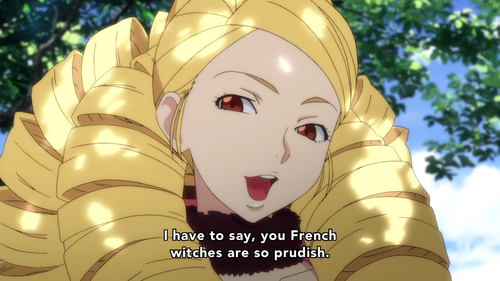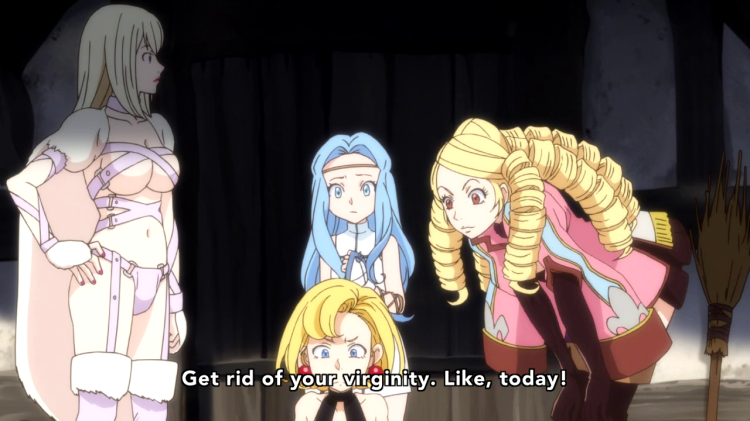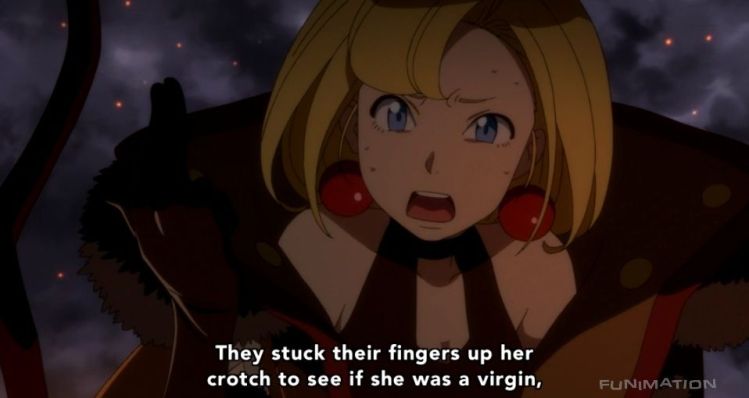Trigger Warning for discussions of sexual violence.
2015 in anime started off right, with an unusually strong winter season. The winter season is usually the dumping-ground for bad light-novel adaptations and harem fanservice, and sure, there was plenty of that. But even before that got off the ground, there was strong hype for Yurikuma Arashi, the latest work by Utena and Penguindrum creator Kunihiko Ikuhara (and something I’m sure will get its own post), as well as new seasons for fan favorites like Jojo’s Bizarre Adventure, Durarara!! and Tokyo Ghoul. (One of those supposedly didn’t live up to its hype, but that’s beside the point.) Even among the new stuff this season, there were a lot of strong choices. Unfortunately, all that hype meant some of the best of them were overshadowed for all but the most diehard anime-viewers.
Then again, looking at the way a lot of the Fandom Feminist Internet (and by that, I mainly mean Tumblr) has wildly misinterpreted Ikuhara’s anime that aren’t Utena, I’m kind of glad that they’re not watching Maria the Virgin Witch–another new show with similar criticisms of the patriarchy (but far less trippy symbolism). This show deals directly with female sexuality and society’s oppression of it in ways that aren’t necessarily relatable or comprehensible to the socially awkward, sex-starved nerds who tend to spend a lot of time obsessing over this online. (Speaking as such a nerd myself.) Maria’s protagonist is a victim of something that a lot of these women—and most white, privileged women in the West—don’t often deal with, but is much more common to other women’s experiences, and comes up a lot in anime for whatever reason. That topic is: compulsory sexuality.
I was first introduced to the concept of “compulsory sexuality” when I saw it come up a lot as a critique to white straight women’s conceptions of the virgin-whore dichotomy like Jessica Valenti’s The Purity Myth. Books like hers focus a lot on how much the patriarchy sucks for the women seen as virginal and pure, when they decide not to act that way. Yet, they tend to ignore what it’s like for women on the other end of the equation. When you’re seen as already having “destroyed” your innocence, through sexual or other “deviant” behavior, or you’re born into that category by virtue of being a racial or sexual minority, the purity myth looks very different. Instead of being expected to keep your legs shut at all times, now you aren’t allowed to close them ever. You have to be completely sexually available to men, and if you’re not there’s something wrong with you.
“You’re already a bad girl,” you’re told. “So why aren’t you a bad girl in the way that makes men happy? How dare you define it in your own terms?” It’s another way that society defines women purely in terms of who we are to men, and denies us any kind of sexual agency. Because it primarily affects marginalized categories of women, though, it doesn’t come up in Western media that much. But maybe it works differently in Japan, because it seems to come up over and over again in anime, from Revolutionary Girl Utena to new Lupin III series The Woman Called Fujiko Mine. Of these, Maria is probably the most direct about this topic.
Maria is, as the title implies, a witch. And a virgin, having focused all her time and energy on improving her magic. Her fellow witches, her owl sex-demons (yes, really), and…well, anyone who comes to know this about Maria, finds this juxtaposition highly unusual. As a woman who’s already on the outs with the church and its traditional ideas about female sexuality, why hasn’t she popped her cherry yet? Even though Maria is still a young teen, she’s constantly subject to pressure about why she doesn’t just lose her virginity yet. Supporters of the church see this as a way to either win her over to their side, or weaponize her sexuality against her. All this is set against the backdrop of the Hundred Years’ War: Maria is in France, which saw the bulk of the conflict’s death and destruction, and wishes to stop the fighting. Both the church and the warmongers themselves, as well as many local people who rely on both, are opposed to this. Maria is a girl ahead of her time, and her time had swift ways to deal punishment to those who stepped too far out of line that way. Especially women, and especially witches.
Maria’s being a witch is important, given the legacy of the trope in anime and in popular culture at large. “Witches” have long stood as warnings for girls who focus too much on themselves and not enough on domesticity or finding a husband: this is what you will turn into one day. Your power will corrupt you and make you evil, and you will be lonely with no husband or child to love. In anime specifically, the “magical girl” genre was inspired by the American show Bewitched, and many early magical girls were explicitly described as witches. Madoka Magica plays with this by having its innocent, sparkly magical girls corrupt into witches when consumed by the world’s despair (a theme more than a few people have interpreted as a feminist parable about female puberty). But perhaps the most important Anime Witch here is Anthy Himemiya from Utena.
Utena is all about the patriarchy, and the way that it strictly prescribes roles for men and women, as “princes” or “princesses.” Everyone is either one of these things, or looks up to and wants to be like them. Anthy is the exception: the last woman who tried to usurp the prince role and failed, but less for masculine heroism (like Utena aspires to) and more to protect her brother. She wasn’t either role, but instead, a strange and uncomfortable merging of the two. For that blow against the system, refusal to follow its rules, she became a witch—and is constantly punished for it with the swords eating at her. She is the Other Woman, with no place even in the future her now patriarchy-corrupted brother promises Utena. Even before that finale, she had no agency in the world of Ohtori Academy, and it was all tied in with her compulsory sexuality. She was the spoils of whoever won the duels, and why shouldn’t she be? She was already ruined, so she didn’t get to say no. Anthy could only ever be cast aside in the perfect Ohtori world, ignored or turned into an object. So that’s how she was treated, and she was “evil” and “deviant” either way, and especially when she tried to find some small amount of agency in manipulation of others. (Hell, even the fandom buys into this.)
There are also shades of this type of female character in how Princess Tutu deals with its own “bad girl,” Rue. She is not a witch exactly, but a dark “magical girl” framed against a more “positive” one, as a way to critique these distinctions. Rue is actually very interested in a boy, but in a way deemed as too predatory, obsessive in the wrong ways. So Drosselmeyer casts her as the villain in his story, ignoring the pain in her life that’s made her the way she is. Once again, it’s because Rue doesn’t fit in the ideal world of Princess Tutu’s fairytale. Luckily, Tutu rejects Drosselmeyer’s divisions and reaches out to Rue, and they all find a happily ever after in a newer, more just world.
All of these characters inform Maria, and both our perception of her as audience members, and how she’s treated in our world. She, too, is punished for a strange combination of an accident of birth, and her choice to color outside the lines.
On the topic of witches, I should say it’s meaningful that this particular feminist critique is set during the Late Middle Ages. Though the Middle Ages in general are often associated with “witch hunts” and burning, it was really only at the very end of the period, moving into the Renaissance, when they became a widespread phenomenon. The publication of infamous witch-hunting manual Malleus Maleficarum in the late 1400s, aided by the recent invention of the printing press, ignited the early modern “witch craze” or at least, spread it like wildfire. Maria is set right before the beginning of this hideous, misogynistic stain on European history, and I can’t help but think the historical placement is intentional. The women who were punished by it were those in similar positions to the witches of Maria’s world and the aforementioned anime worlds: those outside of society, or at least the traditional roles of maiden or wife. As the Reformation spread around Europe and more formerly-Catholic areas turned Protestant, similar ideas were used to attack and marginalize nuns, particularly ones who weren’t so eager to sacrifice even their limited education and authority for rushed, forced Protestant marriages. “Witch crazes” were ammo in both the Reformation and Counter-Reformation, and for those movements’ discontents.
Of course, the characters’ attitudes toward female sexuality aren’t just late-medieval with regard to witches, but women in general. The period’s great “thinkers” debated whether women were naturally “purer” than men or…get this…”more promiscuous.” And when we were the latter, female sexuality was seen as innately dangerous and predatory. There’s a reason that succubi show up way more in folklore and popular culture than incubi. They were the greater threat, since the people who believed in this stuff saw women as more erotically-driven. After all, women were believed to be less intelligent than men, and therefore more easily tempted by baser desires. It’s a view that shows up in female sexuality through the end of the 18th century, only really going away with the advent of Victorian sexual attitudes…but even that really only applied to privileged women. The “women are more sexual” ideal just went underground, applied only to women society had deemed “degenerate” in another way. In both cases, the “looser” sexuality of women was seen as more reason for men to control them.
Of course, one of the reasons why some women do fiercely guard their sexuality is the high personal cost if things go wrong. In the era before widespread contraception and safe, accessible abortions, casual sex was fraught with peril for independent, career-driven women. If you got pregnant, say goodbye to any other goals you might have: your job now was to take care of your baby. It also often meant swift marriage to its father, who legally owned you and controlled your entire life. Society still hasn’t fully moved past this—our society still isn’t comfortable with women who prioritize their careers over raising a family—but it was far worse in Maria’s time.
The show has a useful analogue to this, too: Maria will lose her magical powers when she loses her virginity, thanks to the meddling archangel Michael. This not only keeps her from getting together with the boy she wants (Joseph), but also makes her an easy mark for the church once they learn her secret. Raping Maria shuts her up, and leaves her powerless and no threat to them. Sexual violence has been weaponized against women who step out of line throughout the centuries, but especially in times when effective contraception and safe abortions were nonexistent. It’s a metaphor that hits a little too close-to-home for many women.
So like Penguindrum before it, I can easily see people dismissing Maria’s feminist credentials for that plot point. Sensitively portrayed though it may be, using sexual violence to advance the plot cuts too close for many, and it’s also poorly handled in just about every other show. But to me, that’s all the more reason Maria deserves kudos for getting it right. Maria is indeed a feminist anime, for the poignant and direct way it engages with the pitfalls of female sexuality in a deeply patriarchal culture. It’s a testament to how great this season of anime is that I can say that. We thought we were blessed just by getting a new Ikuhara show, and Yurikuma Arashi has hit it out of the park consistently with its portrayal of lesbian oppression in Japan. For once, though, there’s more than one feminist-minded, woman-centric anime to choose from among currently airing shows. Do yourself a favor and give them both a look.













